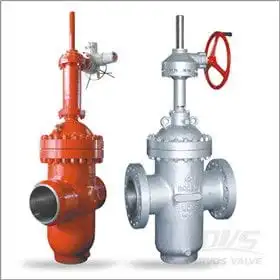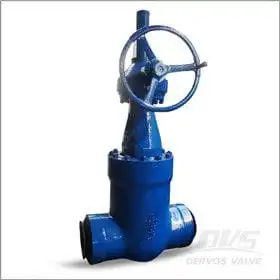Gate valves with rising stems
Turn the hand wheel to raise or lower the valve plate connected to the valve stem by the movement of threads of hand wheels, achieving the purpose of opening and closing.
 Advantages of gate valves with rising stems are as follows:
Advantages of gate valves with rising stems are as follows:Disadvantages of gate valves with rising stems are as the following:
The valve stem's nut is set on the valve plate. The rotation of the handwheel drives the valve stem to lift the valve plate. Usually there is a trapezoidal thread at the bottom end of the valve stem. The thread at the bottom end of the valve and guide groove on the disc will change the rotational motion to rectilinear motion, that is, the operating torque is changed to the operating thrust.
When the valve is opened and the lift height of the plate is equal to the valve diameter, the fluid passage is completely unblocked. However, this position cannot be monitored when the valve is in operation. In actual use, the apex of the valve stem is used as a mark, that is, the position where the valve cannot be opened, as its fully open position. To prevent the valve from being stuck due to temperature changes, when the stem is at the top position, make the stem turn back 1/2 to 1 thread as its fully opened position. Therefore, the fully opened position of the valve is determined by the position of the valve plate, that is, the stroke.
The advantage of this structure is that the height of the gate valve always remains the same, resulting in installation space being small, which is suitable for gate valves with large diameters or restricted installation space. Gate valves with this kind of structure must be equipped with an opening and closing indicator to indicate the degree of opening and closing. The disadvantage of this structure is that the valve stem's thread not only is unable to be lubricated, but it is directly corroded by the medium, causing damage easily.
 Gate valves with rising stems VS gate valves with non rising stems
Gate valves with rising stems VS gate valves with non rising stems1. The lead screw can not be seen in the gate valve with non rising stems, while that can be seen in the valve with rising stems.
2. The lifting screw of non rising stem flange gate valves only rotates and does not move up or down. Only a rod is exposed. The nut is fixed on the valve plate. The valve plate is lifted by the rotation of the screw. The lifting screw of the rising stem flange gate valve is exposed; the nut is attached to the handwheel and is fixed (not rotating or moving axially). The valve plate is lifted by rotating the screw. There is relative rotational movement and no relative axial displacement between screws and valve plates, having appearance of a bracket shaped like a gate.
3. The hand wheel and valve stem of the non rising stem gate valve are connected and relatively immovable when the valve is opened or closed. The valve stem is rotated at a fixed point to drive the valve disc to move up and down to complete the opening and closing. The valve disc of rising stem gate valves is raised or lowered by the threaded drive of the valve stem and hand wheel. To put it simply, the valve disc of the rising stem gate valve moves up and down with the valve stem, and the hand wheel is always at a fixed point.
Next: How Do Cryogenic Valves Work?
Previous: Nov.27th-30th 2012 OSEA
